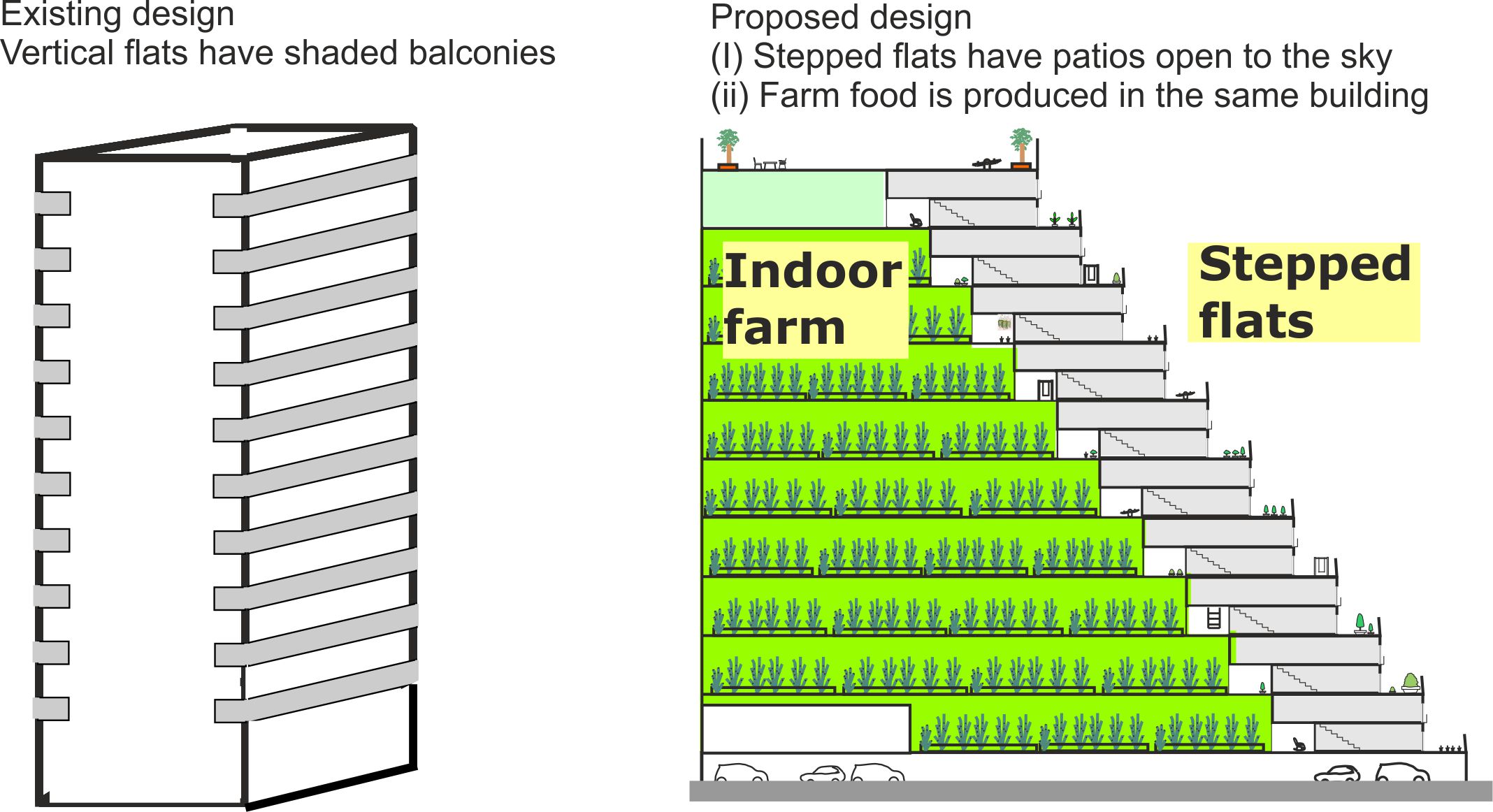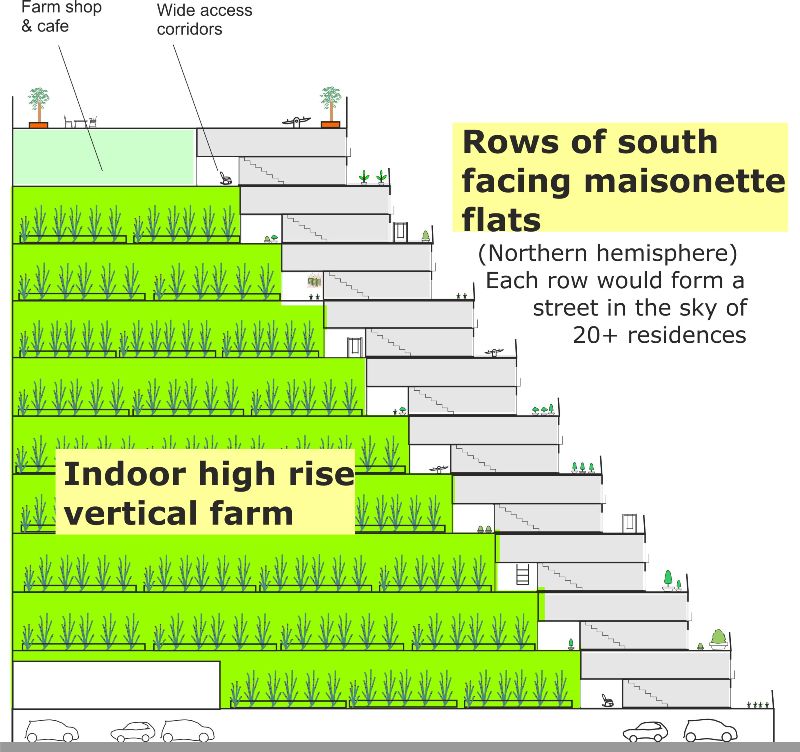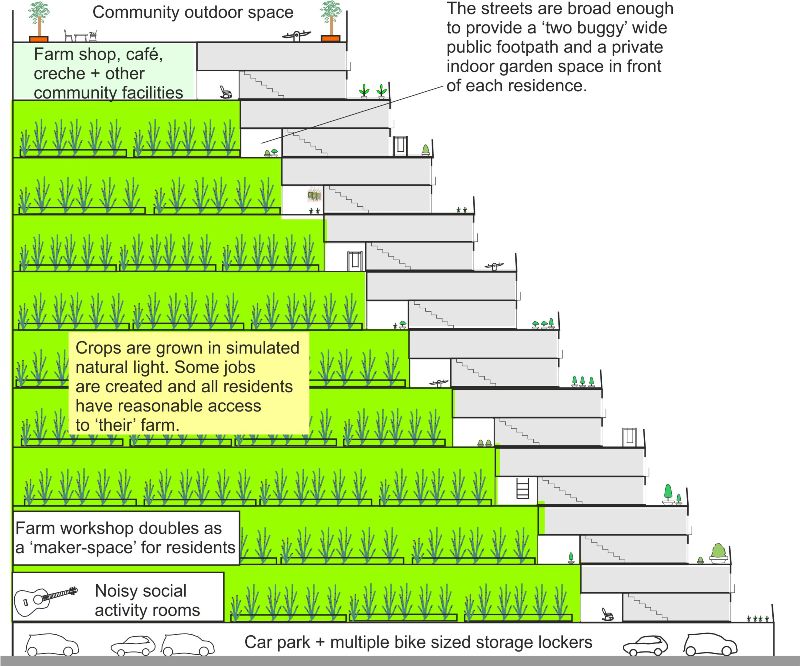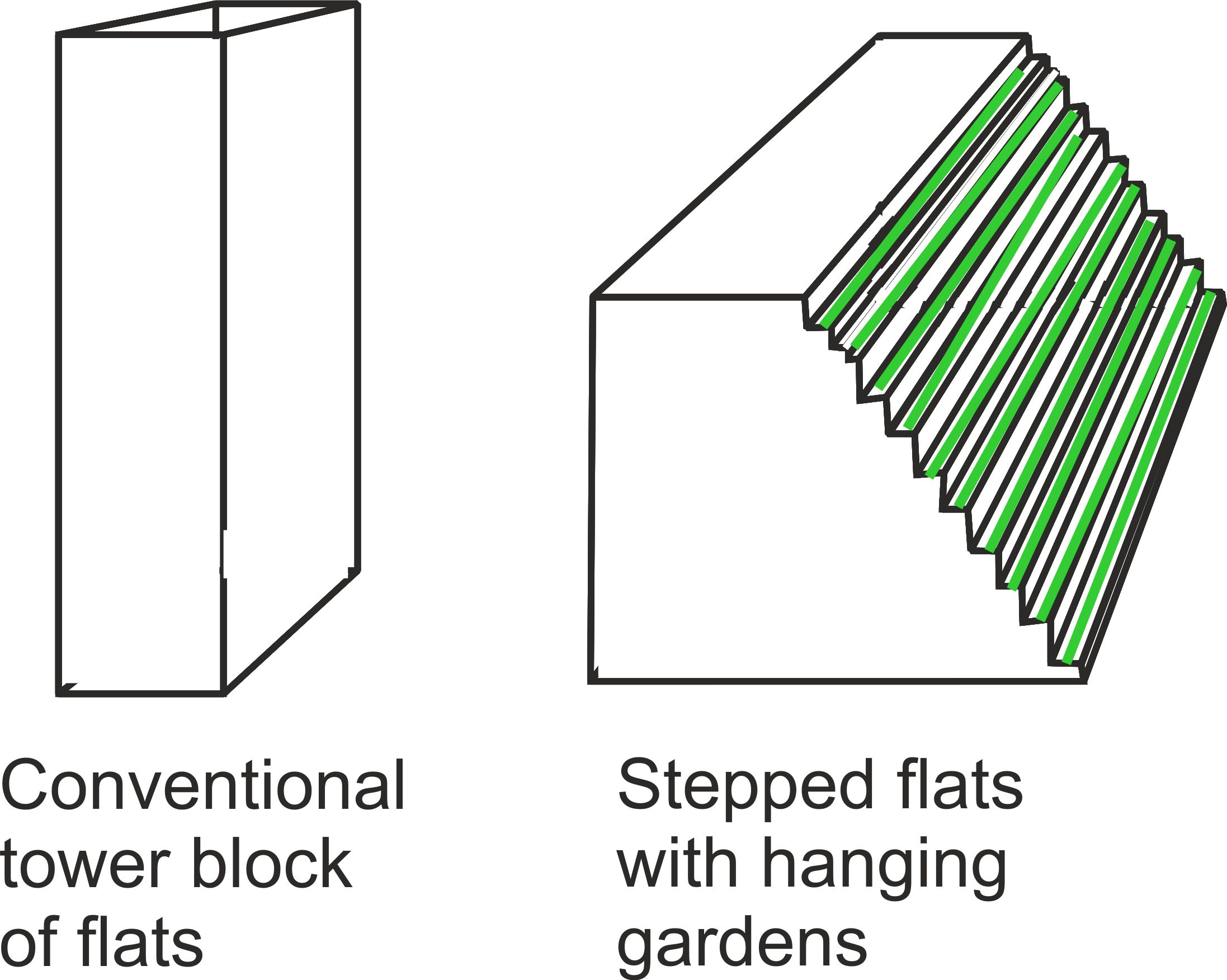The problem to be solved
By the middle of this century 66% of the world population will be living in cities. [http://www.un.org/en/development/desa/news/population/world-urbanization-prospects-2014.html]
Unfortunately modern city lifestyles are making us sick and unhappy.
We tend to eat unhealthy foods and do the minimum of exercise.
We are also becoming more lonely and self centred because superficial friendships on social media such as Facebook are replacing traditional face to face friendships.
The problems have come to a head during the COVID crisis with people of all ages being trapped inside their flats.
But it does not need to be this way.
Planners could re-design housing accommodation so that people are gently nudged back into healthier, happier community lives.
This article concentrates specifically on high rise flat living because it is tragically of current interest to city planners.
The stepped flats we propose will require a larger ground area than conventional high rise flats. But their unusual shape also creates the internal space where the new agricultural science of vertical farming can be exploited. This will allow the flat dwellers to benefit from fresh food, quite literately grown outside their own front doors.
This in turn will reduce the amount of outdoor land needed for growing food, allowing more land with public access to revert back to nature.
Latent Power Turbine power supplies for stepped flats
Atmospheric thermal energy can be used anywhere on the planet to fuel LP Turbines.But in cool climates, defrosting systems will have to be added, to prevent the LP Turbine casing from icing up. So, in cool climates, geothermal energy may be a more convenient than an atmospheric source.
Conventional turbine systems for generating electricity require a geothermal ‘heat’ source of at least 150oC. In contrast, LP Turbines could operate at temperatures just above 0oC, Provided that the geothermal heat flow into the turbine matched the electricity output.
So, in cold northern locations such as Greenland, Northern Canada and Siberia, where good geothermal energy sources have been identified, stepped flats could be powered by geothermal energy.
Regions with deep disused coal mines, such as the Midland Valley in Scotland would also find geothermal energy sources a very attractive option.
Improving patio temperature comfort
In hot climates, the urban heat island effect could be reduced and patio floors kept pleasantly cool b running LP Turbines on thermal energy extracted from a gap between the patio floor and the ceiling of the room below.
In cool climates, a far more modest scheme could be used to warm targeted patio areas by using low cost electricity to warm outdoor tables, seats and snug body warming throws.
Adapting to climate change
If the stepped flats have to be built on flood plains, their ground floors could be used for town activities that can recover quickly after being flood damaged. For example indoor sports areas, market pitches with watertight storerooms and bus stations.
Where the flood risk is only moderate, the ground level can be used for parking vehicles. If closable drains, watertight windows and doors are installed, these can be closed to keep the vehicles dry during a flood.
Stepped flats on flood plains, or with sewage systems that feed into flood plain sewers should be fitted with large emergency septic tanks. These would allow internally generated sewage to be stored until the flood risk has receded.
Rising sea levels pose a dual threat to the inhabitants of low lying tropical islands: their homes will be flooded and their agricultural land will be ruined by salt water. Both of these problems can reduced to a more tolerable level by creating new settlements on higher ground in line with the stepped flats design. Tropical island tourist hotels could also become more self-sufficient in fresh food if constructed in the stepped flats manner.
1 Our core idea: combine high density dwellings with vertical farms
[Information about vertical farms can be found athttps://en.wikipedia.org/wiki/Vertical_farming ]

Figure 1. Growing tubs of plants on the patios will create a hanging gardenseffect.
Adding the farm helps to to create a self sufficient community spirit. (No need for panic buying!)
The new 'Hanging Garden' designs will be more expensive to build and run compared with conventional tower blocks. But the development of Latent Power Turbines could slash these costs.
This is how Latent Power Turbines will help:
- In general, the cost of building materials will fall because the cost of the energy required for manufacturing glass, steel, concrete, bricks etc., will fall.
-
Good quality building sand is scarce and expensive. But LP Turbines will allow poor quality desert sands to be converted into high quality building sand.
- The energy cost of artificially creating summer intensity lighting and temperatures indoors, in cool northern winters will fall.
- Likewise, the cost of cooling buildings in hot climates will fall.
The diagram below illustrates the basic feature of a combined high rise dwelling building and vertical farm.

Figure 2.The long 'street' design allows all the 'Hanging Garden' residences to have south facing patios.
A key feature of indoor farming is that it can provide a steady output of crops throughout the year. This is less financially stressful and more dignified for farm workers (who will hopefully be residents), compared with seasonal farm work.
Bee hives providing access to both indoor and outdoor plant life can be built into the outer walls of the farm.
'Nudges' are subtle features of the design that help people to live healthier lives without having to make a conscious effort.
Here are some of them:
- The two story residences oblige residents to do informal exercise by walking up and down stairs.
- 'Long streets' of 20+ residences encourage people to do more walking and create more opportunities for social encounters with other residents.
-
Helping to improve mental health by providing opportunities for low stress, casual social interaction. For example, each ‘street’ could include at least one large alcove with a moving water feature, seats and a view onto a section of the vertical farm where flowers are being grown for sale.
- Easy access to cheap, fresh local fruit and vegetables encourages healthy eating.
- Ready washed farm food could be sold by the farm shop in small quantities and without packaging. This will encourage daily shopping routines where residents make frequent encounters with other residents.
[The rinsing water would be recycled on the farm.] - South facing patios would encourage exposure to sunlight and and the buildup of vitamin D. This is important for fighting off viral infections.
- Internal air would be filtered and UV light sterilised to reduce the transmission of airborne infections. Pollen from the farm and indoor gardens could also be filtered out.
- LP Turbines will reduce the cost of providing a constant supply of warmed fresh air instead of recirculating stale air.
2 Additional features to improve community life.
Death rates go up during heat waves in warm climates and in winter in cold climates. [https://web.stanford.edu/~moore/HealthBenefitsofWarmer.html]
Hanging garden settlements could reduce death rates at both temperature extremes. We will illustrate the benefits by referring to cool climate living, but equivalent benefits can be gained in hot climates.
Reducing the winter blues for adults and improving eye health for children
Seasonal affective disorder (SAD) is a type of depression that comes on during the darker days of winter. SAD can trigger alcohol, eating disorder and other health problems.
We propose to reduce SAD and improve eye health with high quality lighting.
Overall, halogen lights are better for your eyes than bright white LEDs, with the greatest benefit being enjoyed by growing children. Halogen lights consume more electricity, but this should not be a serious problem in an LP Turbine era.
So, to support community health and encourage residents to mingle, the public spaces should be illuminated by halogen lighting. Residents could also be given an electricity bill discount if they install halogen lights in their homes.
Additional mental health benefits
Domestic violence could be reduced by making the public space into a welcoming sanctuary where an angry partner could 'cool off' after an argument, instead of being trapped in the confines of a traditional high-rise flat.
Other measures to lift community spirits
The diagram below shows some of the nudge features that help to create community bonds.

Figure 3. Mediterranean quality indoor light will lift the spirits in winter, but genuine outdoor light is even better. Low cost clean energy will allow very large south facing windows to be installed without increasing carbon footprints. In addition to patios, shallow balconies could be added to the upper levels.
Integrated health protection for the farm and residents
In accordance with good vertical farming practice, the air in the crop growing areas will be filtered to keep out insect pests and diseases. This eliminates the need for aggressive chemical control.
Using low cost LP Turbine energy the filtration system can be extended to include the residential areas. UVC light based air sterilisation units can be added to destroy any viruses that get through the filters. UVC sterilisation robots (already in use in hospitals) could roam the streets at night to sterilise hard surfaces.
These measures will be cost effective because they will reduce the spread of airborne viral infections including colds, flu, measles, chickenpox, mumps, whooping cough, pneumonia, tuberculosis and corona type diseases.
Asthma sufferers and others will benefit from the removal of pollen and dust particles from the air.
On the other hand, exposure to bacteria also builds up immunity. So building sterilisation regimes need to be restricted to periods when unpleasant infectious diseases are on the rise.
Making the streets vibrant
To prevent children from raiding the farm, it would be separated from the street by a robust but attractively shaped fence that doubled up as a street long climbing frame.
Smart drop-down mesh screens could protect cherished indoor gardens when energetic kids start playing ball games. During a pandemic the screens would allow social distancing between residents sitting in their own private space and others walking down the street.
The streets would be slightly winding with seated alcoves extending into the farm. In normal times these would provide additional play space and ‘stop and chat’ areas for residents. During a pandemic they would create social distancing space for people walking down the street towards each other.
Each 'street level' would develop its own character. To enhance these differences, the farm would grow different crops at different street levels.
Flowers for sale in the farm shop could be grown in beds facing the street.
The variety of indoor gardens would encourage residents to take strolls around their residential building. This would promote social encounters and reinforce the community identity.
The occasional front doorstep equivalent to a car boot sale would also encourage residents to roam around the whole of their residential building.
Lessons on home working from the Corona crisis
Home working during lockdown has protected many jobs and reduced the damage to the economy. It has many time saving and environmental benefits but it can be lonely.
Stepped flats offer a solution to the isolation issue. Working in a street facing room with a large front window open or in the residents own private street space would be far more socially inclusive because it would make the home working experience more akin to working in an open plan office.
Makerspaces
The farm repair shop could double-up as a ‘makerspace’ for use by hobbyists and micro-businesses. Equipment could include sewing machines, lathes, work benches, potter's wheels, kilns etc.
[Makerspaces are discussed at https://spaces.makerspace.com/]
Encouraging local enterprise
Residents may chose to use their indoor 'garden' space to develop their own low risk micro-businesses, for example hair dressing, altering clothes or selling their own baking, artworks, plants and pottery. Takeaway food services that incorporated ingredients from the community farm would encourage healthy eatuing. Some would go on to develop larger businesses in external premises. These local businesses would counter the anonymity of the big name businesses.
- In order to prevent such micro-businesses being exploited as tax free havens, they would need to be VAT registered and provide all customers with a receipt.
- In order to promote business honesty, each community should be entitled to claim a 50% rebate from the VAT authorities for reinvestment in their settlement.
For example, the VAT refund could be used to subsidise the cost of fresh food sold by the farm shop with additional subsidies being offered to residents who bulk purchased food for cooking, for sale to other residents.
Enriching the diversity of homes
The services offered by the micro-businesses could enhance their community in many ways. For example, each block could include a trained , multi skilled handy person.
Their skills would allow them to convert first floor balconies into small conservatories, add pet proof fencing to patios, construct compact and safe kids play furniture, making bespoke plant containers.
Pets are vital for the mental health of many people, but barking, street fouling dogs can be a nuisance. Residents could be obliged to attend dog training classes whenever they acquire a new dog. Expert advice on suitable dog breeds should also be available.
Developing creativity in children (and keeping them out of mischief!)
Children would be encouraged to use the makerspace area, or better still, have their own makerspace. This would include the resources needed to develop adult living skills such as food preparation. The purchase of working materials could be subsidised using the community VAT rebate.
Caring for the elderly & infirm within the community
This could create jobs for younger people while allowing elderly residents to remain within the community.
Features such as the indoor street gardens where residents can sit 'outside' will make monitoring of the elderly and infirm easier.
In order to minimise adaption costs, the marionettes should be designed with the transition into old age in mind. For example anchor points for stair rails and chair lifts should be interchangeable and downstairs storerooms positioned for easy conversion into toilets.
The capital cost of these community buildings will be higher than for traditional high rise flats. But over their lifetimes the health and social benefits of creating genuine communities will outweigh this.
On the other hand, stepped flats would allow a far higher population density than traditional two story dwellings, so land purchase costs would be lower.
Looking after the retired members of our armed forces, especially those who are diabled or traumatised
Service men and women lose the community bonds of their service life when they retire, with many ending up mentally ill and homeless [https://www.mirror.co.uk/news/uk-news/least-13000-hero-soldiers-left-11847000] Finding new homes in community centred hanging garden settlements would help them to adapt to civilian life.
Fire safety standards will be higher than for conventional high rise flats because fire fighting crews and their hoses will be able to gain patio access to all stories. The design would offer several evacuation routes through the vertical farm unit. The escape routes would double up as walkways, allowing residents to take leisure walks.
The installation of sprinklers will be more cost effective because they will be needed for everyday use at each level, for horticultural irrigation. The north facing vertical farm also provides cladding free insulation for the coldest face of the building.
The benefits of mesh screened walkways through the farm
Retracting mesh screens would prevent the adjacent crops from being interfered with by kids. The dense meshes would also provide barrier protection against white-fly and other disease carrying insects, thus reducing the need for insecticides and fungicides.
The walkways would also incorporate gentle air scrubbing features so that transiting pedestrians do not introduce unwanted bacteria into the vertical farms.
Reducing the outdoor fall risk for llively kids, the inebriated and the depressed
T he chances of you dying in a fall from a balcony or window onto hard ground are high once you get to the fourth floor or higher in a building.
So, compared with conventional high rise flats, stepped flats should offer a far lower risk of both accidental and deliberate death by falling.
Short ridged roofs over first floor balconies and rain protection canopies over patios would cushion falls, further reducing risks.
The canopies could be mounted on friction brackets that allow the canopy to move down (say) 20 cm if somebody falls on them, absorbing impact energy.
Canopies would also give a degree of privacy to scantily clad patio sunbathers. Except at the equator, the sun is never vertically overhead. So short canopies would not create deep shadows.
Families with active kids could also enclose their patios in mesh cages (similar to cricketing nets), allowing the kids to play outdoor ball games in safety.
Improving the visual impact of multiple stepped flat estates
The north faces of the flats do not need to be boringly vertical, they can also be terraced.
Potted plants on north facing terraces would receive direct sunlight in the early summer mornings and evenings. With a suitable choice, the plants could provide food and shelter for butterflies, other insects and birds.
During daylight hours, flora on north facing terraces would also benefit from illumination from inside the vertical farm. [LED lighting powered by LP Turbines will be sufficiently cheap that it will not be necessary to worry about light losses through the external walls.]
During the night, blinds would drawn over the farm windows, to prevent residents by irritated by unwanted light.
The farm windows, reinforced glass windbreaks and other large glass surfaces should have disruptive pattern frosted glass outer surfaces to eliminate flare when viewed from a distance and to prevent dazzled flying birds crashing into them.
The stepped flat concept allows plenty of scope for architects to vary the overall shape of the buildings so that they bear a visual similarity to a traditional hillside community.
The LP Turbines that supply power to the residents and farm could be mounted on the east and west faces of the building, so that the air cooling that occurs as a consequence of power production is not a nuisance for the residents.
The illumination for the farm plants could be supplied by off-peak electricity, in anti-phase with the flat residents’ domestic requirements. This would keep the LP Turbine installation requirements to a minimum.

Figure 4. With the aid of low cost LP Turbine power, we can build communities that have more in common with cosy hillside villages than heartless high rise tower blocks.
They would incorporate shapes and patterns found in nature. In order to encourage green foliage coverage, narrow trenches could be built into the outer edges of the patios. This would allow perennial shrubs to be established. Likewise, troughs outside upper story windows and trellis attachment points would allow climbing plants to grow.
Variations on the 'Hanging Gardens' theme. A whole range of alternatives could replace the vertical farms. These could include light manufacturing industries, libraries, schools, university campuses and science research laboratories. 'Living on the job' will cut commuting times and reduce the density of traffic on city roads.
Open prisons that incorporate hanging garden features could help to shift prisoners nearing the end of their sentences from an institutionalised to a mutually supporting community mindset.
Summary
As our cities expand we need to completely rethink the design of our high-rise flats so that they become interactive, largely self sufficient communities where kids have play space and the increasing number of older residents can maintain their independence.

